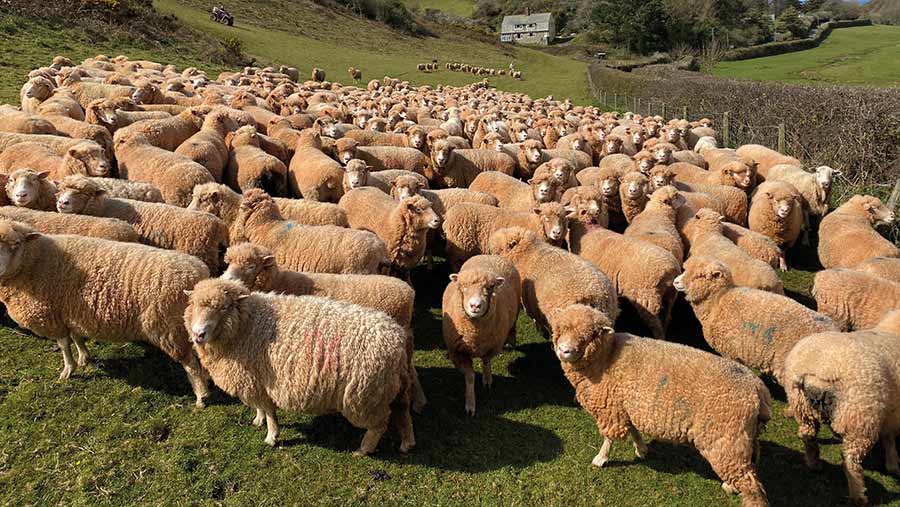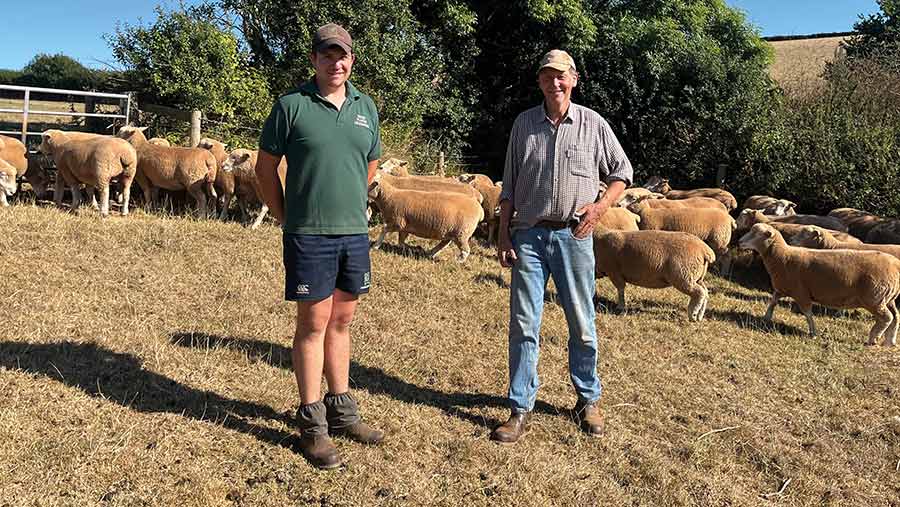How a lamb producer and breeder uses EBVs for marketing rams
 © Richard Rossiter
© Richard Rossiter David Rossiter is a pioneer of performance recording – he started collecting data in the 1970s when he established the Huish flocks at Burton Farm, in Galmpton, Devon.
With his son, Richard, he now manages about 1,400 Poll Dorset, Exlana and Suffolk/Aberblack ewes, an enterprise generating a steady cashflow year-round with sales of breeding stock and finished lambs.
Estimated breeding values (EBVs), which indicate exactly where an animal ranks within the breed for specific traits of economic importance, play an important role in flock profitability, says Mr Rossiter.
See also: Advice for buying rams based on EBVs
“Having those figures allows us to make better breeding decisions, both within our own flock and when breeding females and rams for our commercial and pedigree customers.”
EBVs show his customers how rams compare with the rest of the breed, and which rams and females will be the most profitable on their farms, he says.
Farm facts
- 134ha (331 acres) owned; 273ha (676 acres) rented
- 520 Poll Dorset ewes, lambing in September and October or in January
- 200 Suffolk/Aberblack January-lambing ewes, with shearling rams marketed through Innovis
- 400 pure-bred Exlanas – 100 crossed with Poll Dorsets to lamb in March
- 600 ewe lambs overwintered as replacements or for sale the following year
Using performance records as a marketing tool
In the intervening five decades of recording, he has seen big increases in lamb growth rates, carcass conformation and maternal performance – a situation he attributes directly to his breeding programme.
It has provided a solid foundation for flock improvement and as an aid to marketing – the business sells an average of 130 rams a year, up from 85 in 2018.
Four years ago, they set an annual sales growth target of 10% and they are achieving that.
“If you can improve volume, you don’t have to cane customers on price – if you do that they won’t come back. It has to be profitable for us but also for our buyers,” he says.
“Making breeding records available to our customers means they can find the right sheep for their system, whether that’s selecting rams to accelerate lamb growth rates, improve carcass conformation or whatever trait they are interested in.”
Breed-specific EBVs
The Huish sheep enterprise is made up of:
- Pedigree Poll Dorsets. The Rossiter’s flock was recognised by the Poll Dorset Sheep Society as the champion large flock in the UK in 2021
- Suffolk/Aberblack ewes, developed with finer bone for lambing ease and greater conformation; with their fast growth rate they have proved attractive with commercially minded customers
- Wool-shedding Exlana ewes, bred for minimal shepherding and efficient use of poorer pasture
- Some commercial ewes that do not quite make the grade to join the pedigree flocks.
The important figures differ between the breeds. “For the Exlana, it might be litter size, but also muscularity, to add a bit more muscle to the type of sheep a customer wants to produce,” says Mr Rossiter.
“While for the Suffolk/Aberblack, muscularity and leanness are important, but so too is liveweight gain.
“In the Poll Dorsets, it’s all about the eight-week EBV – the best gauge of how milky ewes are going to be. We pick ram lambs just after weaning based on that EBV,” he explains.

Richard (left) and David Rossiter © Richard Rossiter
Visual selection
Figures should not be used in isolation, Mr Rossiter advises – visual appearance is important, too.
“EBVs add to the picture but, for me, the stock I will use as sires have to look right, too.”
He encourages private customers to look at the entire group being offered for sale and to select twice as many as the number they intend to buy.
“We then run the sheep up the race and look at their performance figures behind them, and put those in the context of what the customer is wanting to achieve with them – whether that’s improving muscle density, perhaps, or growth rates, in their own flock.
“We can then see which animals are going to deliver the best on those, so the customer will end up with the animals they like the look of and those with the traits to perform.”
There is no doubt that performance recording has dramatically improved his flocks, but he says he could not keep making progress without culling poor-performing ewes.
“I find it most effective to make that decision at lambing time. The most efficient flock is one that keeps on culling,’’ says Mr Rossiter.
Livestock marketing tips
Estimated breeding values are just one layer in David Rossiter’s strategy for reaching customers. Other marketing methods used include:
1. Displaying stock at events
At the National Sheep Association event this year, sheep from the Huish flocks were displayed on the Exlana and Dorset Horn & Poll Dorset Sheep Breeders Association stands.
“It does mean work and effort, but you have to be seen, to be out there,” says Mr Rossiter.
2. On-farm sales
The Rossiters held their first on-farm sale in August, in part to fill the void in their export sales post-Brexit.
On-farm auctions are emerging as a popular alternative sales platform. For sellers who might otherwise have two or three visits a week from buyers for six weeks during the selling period, these auctions are more convenient.
3. Private sales
This can be a time-consuming system for selling one or two rams, but it allows for relationship-building. It also eliminates the risk of cross-contamination at a sale.
“From a flock health point of view, we are maedi visna accredited and part of the Scrapie Monitoring Scheme across all the flocks,’’ says Mr Rossiter.
4. Social media
When the pandemic paused live sales and customer visits to the farm, the business got active on social media. It is not unusual for a single post to get 350 views in a 12-hour period.
“Richard is very good with technology and posted a few videos on Facebook,” Mr Rossiter recalls. “We got a tremendous response and we have just continued from there.”
He recommends restricting posts to relevant material. “Small, domestic issues such as drenching the flock or dealing with a lame sheep have no relevance to what we are doing, so we wouldn’t put up posts about those,” he says.
5. Reputation
Mr Rossiter says a key factor in successfully marketing breeding stock is to establish a reputation for being a reliable and consistent breeder.
“Don’t think you can keep a poor lamb for 18 months and sell it to another flock, it won’t do your reputation any good,” Mr Rossiter warns. “An animal like that needs to be culled out of the flock.”
